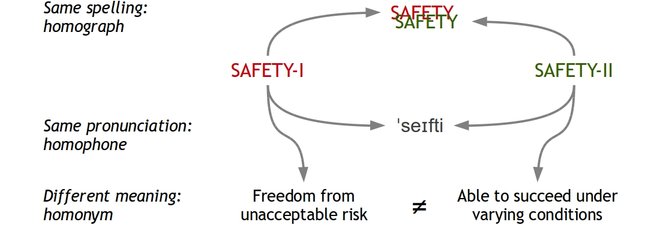(c) Erik Hollnagel, 2020
SafetySynthesis facets: Safety as a homonym
Safety-I and Safety-II represent two completely different views of what safety is:
- In Safety-I, safety is defined as a condition where as few things as possible go wrong. Safety is therefore achieved by preventing things from going wrong, i.e., by looking at and responding to unwanted outcomes and the events that may lead to that.
- In Safety-II, safety is defined as a condition where as many things as possible go right. Safety is therefore achieved by trying to make sure that as much as possible goes right, i.e., by understanding work-as-done and trying to facilitate that.
The same word ('safety') thus means two completely different things. Safety is therefore in this context a homonym. A homonym is a word that has different meanings, but which is in each case has the same spelling and the same pronounciation.
This is clearly neither desirable nor practical. It can also easily lead to confusion in discussions, since it may be difficult to know whether someone who uses the term 'safety' refers to the Safety-I interpretation or the Safety-II interpretation. The easiest way out of this problem would be to find a different word to represent what Safety-II stands for. The use of the terms Safety-I and Safety-II, however, has considerable rhetorical value because it makes clear that the traditional understanding of safety is not the only one. Yet in the long term it becomes cumbersome to use a term and then immediately add that it is actually used with a completely different meaning.
There is another reason why it may be a good idea to find a different term. That is that a reference to safety (in the Safety-I sense) distances it, or separates it, from other perspectives on work, such as quality, efficiency, reliability, productivity, etc. Focusing on the things that may go wrong clearly singles out one aspect of work - namely the unwanted outcomes. Focusing on, e.g., quality singles out another aspect of work. The same goes for productivity, and so on. While there may have been some reason for doing so in the past, beginning in the first decades of the 20th Century, and even some reasonableness in doing it, that is no longer the case. In most kinds of work activities (or functions) are now so tighly coupled with each other, that it may be counterproductive to focus on one aspect at a time and leave out the others.
(06July2014)

